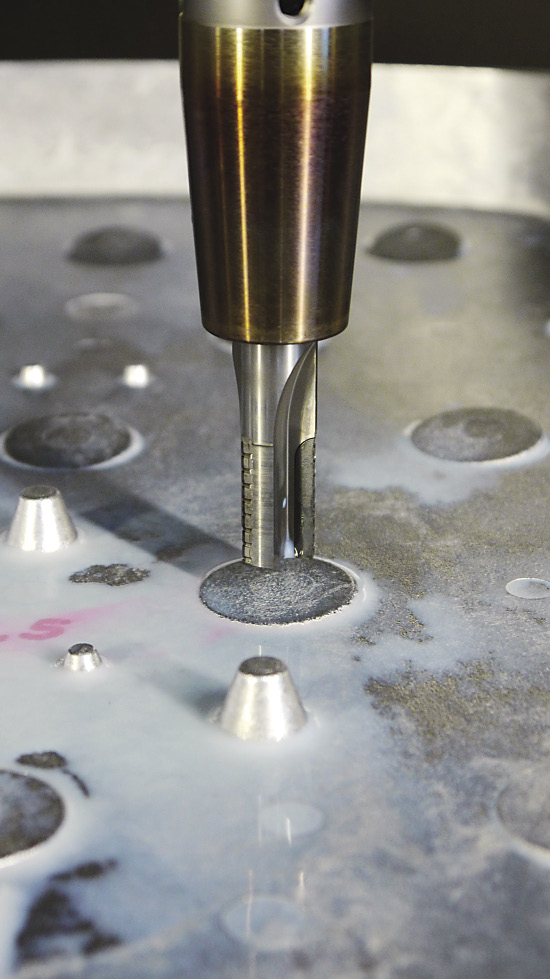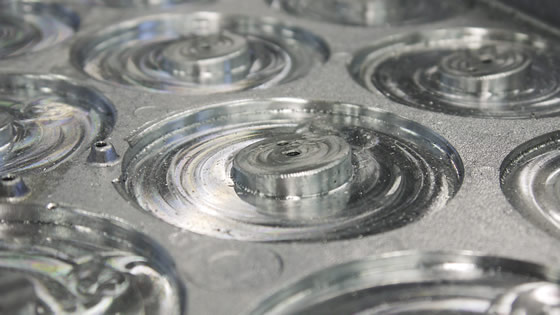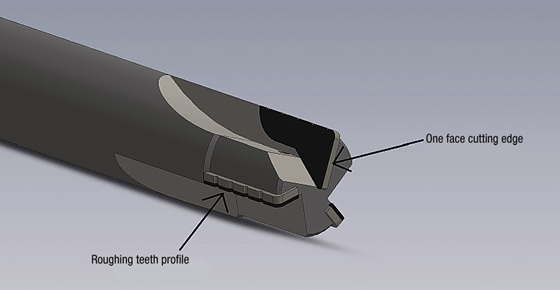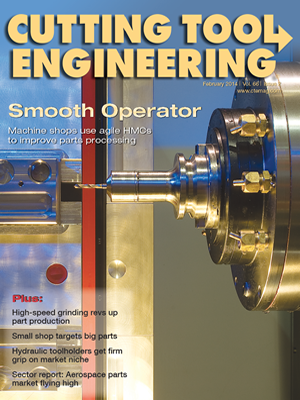END USER: Simeon Medical GmbH & Co. KG, +49 74-61-900-68-0, simeonmedical.com.
CHALLENGE: Boost productivity and extend tool life when cutting cast aluminum surgical light housings.
SOLUTION: A special PCD endmill with laser-machined cutting edges.
SOLUTION PROVIDERS: J.M. Sales USA, (248) 321-6170, www.jmsales-usa.com; Johs. Boss GmbH & Co. KG (JBO), +49 74-32-9087-0, www.johs-boss.de.
It’s common knowledge that superhard materials can be used to make cutting tools with exceptionally long life. But a medical device maker really hit the jackpot when it replaced a solid-carbide endmill with a PCD one and experienced a more than 5,600 percent improvement in tool life, while efficiently producing high-quality parts. Simeon Medical GmbH & Co. KG, Tuttlingen, Germany, experienced that outcome when the manufacturer of surgical light housings needed a longer lasting endmill to more productively mill circular pockets in the cast aluminum housings. Depending on the model, each housing has 24 to 36 pockets to hold LED lights.
The parts manufacturer was applying uncoated solid-carbide endmills that had roughing teeth with a chipbreaker geometry. Tool life averaged from 12 to 14 housings. Simeon tested a coated carbide tool, but tool life increased only three to five housings.

A special PCD endmill from JBO mills a circular pocket in cast aluminum at Simeon Medical.

Seeking to reduce costs and further extend tool life, Simeon commissioned Johs. Boss GmbH & Co. KG (JBO), Albstadt, Germany, to develop a solution. (J.M. Sales – USA, Troy, Mich., is JBO’s U.S. representative.) The toolmaker selected PCD as the cutting tool material and produced an endmill with chipbreaking roughing teeth. The 3-flute tool measures 16mm (0.63 ") in diameter and 90mm (3.54 ") in total length and has 24.90mm-long (0.98 "), 1.60mm-thick (0.06 ") PCD cutting edges with a 0.80mm (0.03 ") end radius.
In addition, JBO laser-machined the cutting edges. Compared to the conventional method of wire EDMing the edges, laser machining produces an ultrasharp cutting edge with minimal chipping and edge rounding, according to JBO. For example, if the EDM’s eroding wire is 0.3mm (0.01 ") in diameter, the cutting edge radius is 0.15mm, whereas laser machining can generate an edge radius as small as 0.02mm (0.0008 "), explained Sandro Conzelmann, application technician for JBO. “And we can produce more filigree geometries than is possible with wire erosion,” he said.
Within a week of the inquiry, Conzelmann noted JBO was able to provide a tool. According to JBO, the initial PCD endmill lasted from mid-July 2013 to the end of November, producing more than 800 housings. In addition to reducing frequent and time-consuming tool changes, the PCD tool cut cycle time 18 minutes compared to the solid-carbide tool by running at higher speeds and feeds. The PCD endmill runs on a Hermle machining center at a spindle speed of 17,000 rpm, a cutting speed of 855 m/min. (2,805 sfm) and a feed rate of 8,000 mm/min. (315 ipm).

JBO designed the PCD endmill for Simeon Medical with roughing teeth on the external diameter and a face cutting edge.
The total cost for two special PCD tools is $886 compared to $82 to $109 for one standard solid-carbide tool, Conzelmann noted.
Also, the stability of the PCD tool edge eliminates burr formation, according to JBO. Therefore, Simeon eliminated the 10 minutes required to manually deburr a part after machining it with a solid-carbide endmill.
Related Glossary Terms
- burr
burr
Stringy portions of material formed on workpiece edges during machining. Often sharp. Can be removed with hand files, abrasive wheels or belts, wire wheels, abrasive-fiber brushes, waterjet equipment or other methods.
- chipbreaker
chipbreaker
Groove or other tool geometry that breaks chips into small fragments as they come off the workpiece. Designed to prevent chips from becoming so long that they are difficult to control, catch in turning parts and cause safety problems.
- cutting speed
cutting speed
Tangential velocity on the surface of the tool or workpiece at the cutting interface. The formula for cutting speed (sfm) is tool diameter 5 0.26 5 spindle speed (rpm). The formula for feed per tooth (fpt) is table feed (ipm)/number of flutes/spindle speed (rpm). The formula for spindle speed (rpm) is cutting speed (sfm) 5 3.82/tool diameter. The formula for table feed (ipm) is feed per tooth (ftp) 5 number of tool flutes 5 spindle speed (rpm).
- endmill
endmill
Milling cutter held by its shank that cuts on its periphery and, if so configured, on its free end. Takes a variety of shapes (single- and double-end, roughing, ballnose and cup-end) and sizes (stub, medium, long and extra-long). Also comes with differing numbers of flutes.
- feed
feed
Rate of change of position of the tool as a whole, relative to the workpiece while cutting.
- laser machining
laser machining
Intensified, pulsed beams of light generated by lasers—typically carbon dioxide or neodium-doped yttrium aluminum garnet (Nd:YAG)—that drill, weld, engrave, mark, slit and caseharden. Usually under CNC, often at both high cutting rates (100 linear in./sec.) and high power (5kW or more). Lasers also are used in conjunction with in-process quality-control monitoring systems allowing measuring accuracies of 0.00001".
- machining center
machining center
CNC machine tool capable of drilling, reaming, tapping, milling and boring. Normally comes with an automatic toolchanger. See automatic toolchanger.
- milling machine ( mill)
milling machine ( mill)
Runs endmills and arbor-mounted milling cutters. Features include a head with a spindle that drives the cutters; a column, knee and table that provide motion in the three Cartesian axes; and a base that supports the components and houses the cutting-fluid pump and reservoir. The work is mounted on the table and fed into the rotating cutter or endmill to accomplish the milling steps; vertical milling machines also feed endmills into the work by means of a spindle-mounted quill. Models range from small manual machines to big bed-type and duplex mills. All take one of three basic forms: vertical, horizontal or convertible horizontal/vertical. Vertical machines may be knee-type (the table is mounted on a knee that can be elevated) or bed-type (the table is securely supported and only moves horizontally). In general, horizontal machines are bigger and more powerful, while vertical machines are lighter but more versatile and easier to set up and operate.
- polycrystalline diamond ( PCD)
polycrystalline diamond ( PCD)
Cutting tool material consisting of natural or synthetic diamond crystals bonded together under high pressure at elevated temperatures. PCD is available as a tip brazed to a carbide insert carrier. Used for machining nonferrous alloys and nonmetallic materials at high cutting speeds.


